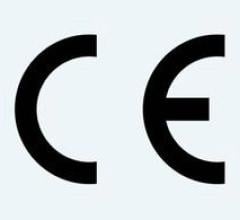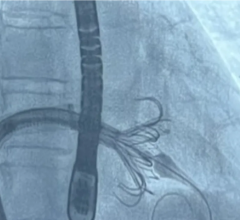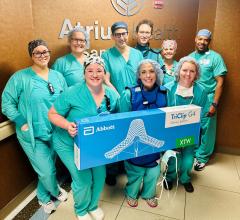The biggest technology news coming out of the 2015 American College of Cardiology (ACC) annual scientific sessions involved the overwhelmingly positive late-breaking trial data for transcatheter aortic and mitral valve repair. ACC dedicated an entire day of late-breaking trial presentations to this new technology, highlighting its importance in how cardiology will be changing in the coming years, moving from invasive surgical repairs to minimally invasive percutaneous therapies. There were reservations a couple years ago among most cardiologists that transcatheter procedures would not live up to the durability and outcome standards set by surgical valve replacement, but data continue to show it is comparable, and in some cases, better.
Watch a video explaining trends in the ACC.15 TAVR data.
The poster child for transcatheter aortic valve replacement (TAVR) last year at ACC.14 was the Medtronic CoreValve, which showed a trend toward better outcomes than surgical repair. It maintained that trend in 2015, with this year’s two-year results showing CoreValve patients faired better than surgical valve replacement patients. This result stirred conjecture in a couple sessions I attended that the question in the future may change from who is best served by TAVR, to who is best served by surgery? Read about the CoreValve two-year results.
The Edwards Lifesciences Sapien valve also performed well. The final five-year PARTNER Trial data for high-risk patients treated with the first-generation Sapien valve demonstrated equivalent outcomes to traditional open-heart surgery. There was also no structural valve deterioration requiring intervention. Additionally, data for the improved Sapien 3 device demonstrated lower death, stroke and paravalvular leak rates than earlier generation devices in high and intermediate risk patients in the PARTNER II S3 Trial. The Sapien 3 uses a skirt of material at its base to better seal the annulus to prevent paravalvular leak.
The clinical data for a TAVR embolic protection system was also presented for the Keystone Heart TriGuard system being tested in the DEFLECT III trial. It showed a 10 percent reduction in stroke rates.
Interventional Cardiology
The SYNTAX trials several years ago attempted to show drug-eluting stents (DES) could provide outcomes as durable as coronary artery bypass graft (CABG) surgery, but it ended with surgery edging out stents. The BEST trial presented at ACC.15 was a rematch using current generation DES, which was expected to perform better than the Taxus stent used in SYNTAX. However, results were disappointing, with surgical outcomes again trumping DES. Data show patients receiving angioplasty with newer everolimus-eluting stents had a 47 percent higher risk of one of the outcomes identified as a primary endpoint in the study — death, heart attack and subsequent procedure to clear blocked arteries — as compared to patients who received CABG.
Cardiac CT Imaging
Two trials highlighted at ACC show a continuation of supporting data to use computed tomography angiography (CTA) as the primary diagnostic exam for patients who present with chest pain. The SCOT-HEART Trial (The Scottish Computed Tomography of the Heart Trial), which included more than 4,000 patients, showed a 38 percent reduction in the number of heart attacks in patients who received a CT scan compared with the control group getting the standard of care. The study also showed CTA changed patients’ diagnosis in about 25 percent of cases, whereas using the standard of care diagnosis were only changed about 1 percent of the time.
The PROMISE Trial showed CTA is extraordinarily effective in accurately diagnosing patients with low to moderate chest pain. In most cases, coronary CTA is at least as effective as diagnostic methods, such as stress tests including SPECT myocardial perfusion imaging, data show.
New Technology
There were several new cardiovascular technologies showcased on the ACC expo floor. Watch the video Editor’s Choice of the Most Innovative New Technology to see some of my choices for the most interesting new devices.



 March 31, 2025
March 31, 2025 








